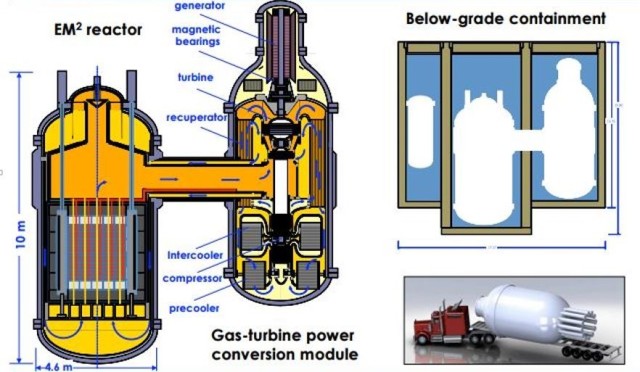Factory made, dropped into a bunker or a mine, run uninterrupted for 20 or 30 years using leftover ‘nuclear waste’ – of which there is enough for hundreds of years of energy supply. And then recycle the fuel core to burn more of the energy in fissionable material. Producing far more power from the same ore with with far less waste and far shorter lived – 300 as opposed to 30,000 years – fission products. Replacing aluminium fuel cladding with silicon-carbide. Melting aluminium in superheated steam produces hydrogen which then explodes. In the history of bad ideas – this one gave us Chernobyl and Fukushima. General Atomics is supplying silicon-carbide coated fuel piles in different control rod shapes. 21st century materials and fuel pile design are critical to small modular reactors – quite literally. These can’t melt down and explode whatever happens. The nuclear pile can not get hot enough – physics says – to melt silicon-carbide fuel cladding.

The are dozens of versions of small modular reactors starting to come online around the world. The General Atomics version is the Energy Multiplier Module – EM2. Helium cooling instead of water means the module can be placed nearly anywhere Powering powering society for 100’s of years converting 1000’s of tonnes of existing nuclear waste into energy.

The fuel pile can burn undisturbed for 20 or 30 years – and then be taken away and recycled – adding additional fertile material – and removing a few percent of light fission product in an AIROX process.

The left bar is the creation of an intractable problem with long lived radioactive isotopes – and a huge waste of a resource. What remains with EM2 are fission products – the rest of the mass is converted to energy – E-MC2 – that decay and lose heat in 100’s of years rather than 10’s of 1000’s.

The fourth objective – after safety, waste and proliferation is cost. If it doesn’t work commercially it doesn’t work period. Below is estimated costs of 8 advanced reactors in the US. On average a sizable cost reduction for these simpler, smaller, safer products.

Click to access Advanced-Nuclear-Reactors-Cost-Study.pdf
General Atomics isn’t one of the 8 – but give their break even point with natural gas as $6-7/MMBtu. The US natural gas price is $2.95/MMBtu – with a domestic glut and export control. Australia has an expensive regional gas price – it is tied to the price of our gas in Japan. That’s a greenie over supply problem. We could be frakking the hell out of things. So for most of the world – these are looking cost competitive. And more so as energy demand multiplies in the next few decades and supply tightens.
These SMR’s have the reverse problem of wind and solar – wind and solar don’t have enough power most of the time. SMR have too much power most of the time as demand rises and falls. SMR provide opportunities for other uses of heat and power. Catalyzing production of hydrogen and oxygen from superheated steam. Making liquid fuels from hydrogen and CO2. CO2 from air, electricity plants or cement and steel makers? Fossil fuels do have an innate supply and demand constraint. Fossil fuel prices get higher over time as demand increases and finite stocks are utilized. If there is something else far safer and easier at lower cost? There is no question.
